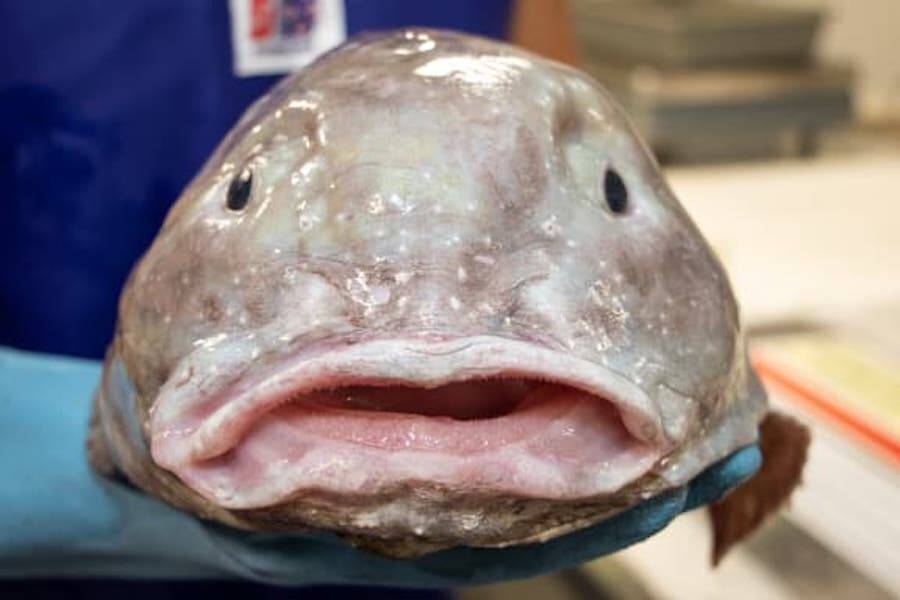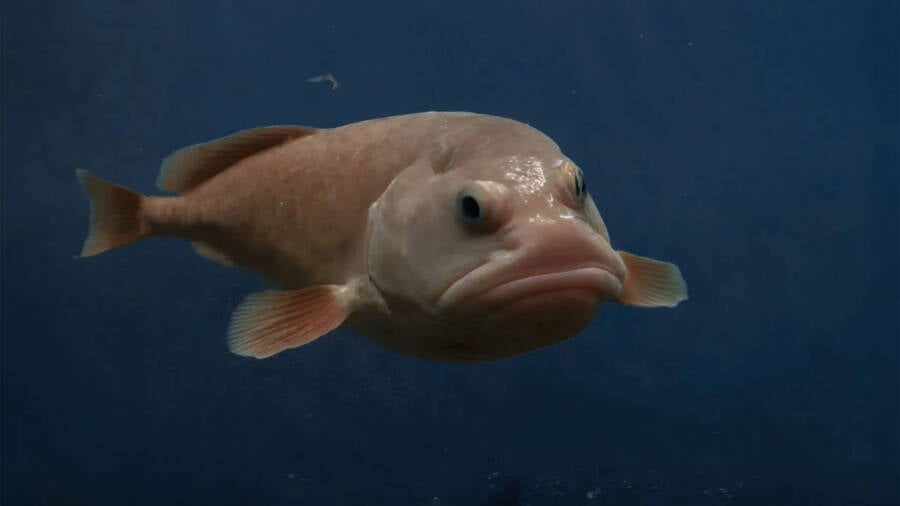The Real Story Behind The Blobfish, The So-Called ‘Ugliest Animal On Earth’
The Real Story Behind The Blobfish, The So-Called ‘Ugliest Animal On Earth’
Found in the deep seas off the coasts of Australia, Tasmania, and New Zealand, the blobfish looks very different underwater.
In the early 2010s, a recently discovered marine creature went viral on the internet: the blobfish.
As its name implies, this fish isn’t the most visually appealing species in the animal kingdom. And considering the bizarre photos of the creature, which are often used in internet memes like, “Go Home Evolution, You’re Drunk,” it’s hard to believe that it’s a fish at all.

Australian MuseumMr. Blobby, arguably the world’s most famous blobfish.
Nonetheless, our desires for the weird and surprising have propped the deep-sea species to the forefront of internet culture and yielded a widespread awareness of the blobfish. The specimen seen above, cleverly dubbed “Mr. Blobby,” even won a World’s Ugliest Animal Competition, which was put on by the U.K.-based Ugly Animal Preservation Society in 2013.
But interestingly enough, the so-called “ugly” blobfish might not be that ugly after all. As it turns out, the most commonly shared pictures of the creature do not show it in its natural state — but after it’s been forcefully removed from the deep sea, where it usually resides. Here’s everything you need to know about one of the ocean’s most misunderstood animals.
The Discovery Of “Mr. Blobby”

Bhakti Patel/Radio New ZealandA blobfish held by a researcher aboard the RV Tangaroa.
The blobfish was discovered in 2003 by a team of researchers who were exploring the oceans near New Zealand while aboard the RV Tangaroa. Towing trawling gear across the ocean floor, the scientists found over 100 new species of fish and invertebrates — one of which was the blobfish.
It was Kerryn Parkinson, a marine ecologist and photographer, who first encountered the animal that would come to be known as “Mr. Blobby.” Struck by the fish’s unforgettable appearance, she snapped a photo. “He looked so human!” she remembered, according to the Smithsonian Magazine. “He had that certain charisma that demands attention.”
Mark McGrouther, the fish manager of the Australian Museum (where Mr. Blobby would later be preserved and put on display), described the specimen as a “very soft, very goopy fish, about the length of a comic book. While the ship swayed, the jiggly mass slid to and fro, even in death.”
Some have wondered whether the blobfish received its name, Mr. Blobby, from the 1958 horror movie The Blob, but that seems unlikely.
“Personally, I doubt that explanation,” said McGrouther. “I think it’s called Blobby because, out of the water, it’s a limp, flabby thing that can’t support its own weight. So it splodges.”
Though it’s understandable why many would be fascinated with the blobfish’s appearance, it looks very different when it’s alive and underwater. And, of course, there’s more to it than its so-called unattractiveness.
The Fascinating Life Of The Blobfish

American OceansWhen it’s underwater, the blobfish certainly doesn’t look like the ugliest animal in the world.
Officially known as the Psychrolutes marcidus, the blobfish is part of the fathead sculpin family, which lives in the Pacific, Atlantic, and Indian Oceans anywhere between 330 and 9,200 feet below the ocean surface.
According to the Australian Museum, the name “fathead sculpin” indicates that these fishes typically have a large, globular head and floppy skin.
And as seen in the image above, blobfish look far less “blobby” when they’re thriving in their natural, cold-water, deep-sea habitat.
“The infamous picture of the blobfish, Mr. Blobby; it’s not good, right?” said Just the Zoo of Us podcast host Christian Weatherford. “The blobfish in that picture looks the way it does because of damage it took because of the rapid change in pressure… If they are pulled out of the water quickly from a deep depth, they don’t have time to react to the change in pressure, biologically, so it causes damage to their bodies.”

Wikimedia CommonsAn illustration of what a blobfish looks like in its natural state.
But while experts do have a good idea of what a blobfish is actually supposed to look like underwater, unfortunately, little is known about this creature’s actual biology. Some specimens have been found with gastropods in their stomachs, so it’s likely that they feed on prey like mollusks.
Their life expectancy is also unknown, though according to the Smithsonian Magazine, most fish that live in deep water tend to live longer than those in shallow water. Some deep-sea species can live for over 100 years. Experts are also unsure as to how blobfish mate, though Mark McGrouther suggested, “I’d guess they lock in a clinging, rather conjugal embrace.”
However, scientists do know that blobfish definitely lack something that most other fish have — a swim bladder. Many fish require a swim bladder in order to maintain their buoyancy in the water. “If Mr. Blobby had an air sac, he would collapse under the extreme pressure,” McGrouther explained. “Instead, he uses water as a structural support.”
Since this animal’s body is notably less dense than water, it’s able to drift passively above the seabed, accepting whatever meals might come its way. But because food can be tough to come by near the ocean floor, some experts began to wonder whether the blobfish might be endangered — leading to even more misunderstanding around this creature.
The Public Debut Of The Blobfish

KYODOThough blobfish are rarely captured alive, “Bob” was successfully put on display at Aquamarine Fukushima in Japan.
In 2010, Mr. Blobby made his first public appearance on an Australian television show called “The Gruen Transfer.” Centering around the advertisement industry, the show issued a challenge to two agencies: Make Mr. Blobby a star by encouraging the public to “save the blobfish.”
One firm in Sydney edited an image of Mr. Bobby to make the creature look more attractive, while another firm in Brisbane took it a step further.
The Brisbane agency sent a plump, middle-aged man clothed only in swim trunks and a fake long nose to “blob” through the streets, holding signs that read, “How Would You Like It If I Trawled Your Bottom?” and “50,000 Signatures and I Go Back to Where I Belong.” Before long, Mr. Blobby had garnered a social media following — and interest around the world.
Immortalized in humorous memes, lovable stuffed animals, GIFs, and emojis, the blobfish became something of a global phenomenon. An artist named Michael Hearst even wrote a song in the blobfish’s honor:
To this day, the blobfish has a loyal following on Twitter, Instagram, and Facebook, amassing thousands of likes and shares.
On one website, Mr. Blobby predicts the winner of the FIFA World Cup. On another, he predicts the winner of the MasterChef Australia competition. He even goes so far as to do live interviews on the red carpet of Australia’s Eureka Prizes, a science award ceremony. But nothing boosted the blobfish’s profile as much as the World’s Ugliest Animal Competition of 2013.
That year, Mr. Blobby’s fame ballooned when he won the title of the ugliest animal in the world and became the mascot of the Ugly Animal Preservation Society, the U.K.-based organization running the competition in the interest of protecting endangered animals that don’t get enough attention.
Was The Endangered Label Warranted?

Aquamarine FukushimaBob the blobfish swimming at Aquamarine Fukushima.
The Ugly Animal Preservation Society’s president, biologist Simon Watt, has often pondered why certain types of endangered animals get the love and affection from the public while other equally threatened species do not.
“People have always shouted ‘Save the Whale,'” Watt explained, “but until now no one has stood up for gob-faced squid or the hundreds of species that go extinct every day… We prefer big eyes, bushy tails and animals that have, at the very least, recognizable faces.”
But as it turns out, the widespread worries over the blobfish were largely overblown. The rumor that Mr. Blobby was a member of an at-risk species came from several sources. According to The Telegraph, the blobfish risked extinction by being the victim of overfishing near Australia and New Zealand.

National Science FoundationA blobfish in its natural habitat.
In this piece, marine expert Professor Callum Roberts of the University of York stated, “Blobfish are very vulnerable to being dragged up in these [trawler] nets… A very large amount of the deep sea is under threat from bottom trawling which is one of the most destructive forms of fishing.”
Further promoting this theory was a story published by The Guardian, stating that blobfish were the victims of “anthropomorphic lookism”:
“The blobfish has something better than the regular features and soft contours of conventional beauty: with its droopy mouth and gelatinous cheeks, it has an appealing vulnerability. Unfortunately, not enough to tug at the heartstrings of deep-sea trawlermen fishing off the Australian coast, for whom it’s just collateral damage.”
Fortunately, for the blobfish, these rumors about endangerment turned out to be just rumors. The blobfish was, in fact, healthy and thriving as much as it could in the crushing depths of the ocean that it called home.
“Mr. Blobby” Today And The Future Of Blobfish

Wikimedia CommonsFortunately, the blobfish isn’t on the verge of extinction as some may have thought.
When Simon Watt eventually learned in 2015 that the blobfish isn’t an endangered species in the slightest, he was relieved.
“I’m pleased but sad,” he said in response. “Pleased because anything not endangered makes me happy, but sad because maybe the award should have gone to an animal like the Tonkin snub-nosed monkey, which is in dire straits and could use the press. But if the blobfish’s victory has made people aware that extinction is a wider problem, that’s all for the good.”
When asked whether or not the title of the world’s ugliest animal was appropriate, Mark McGrouther adamantly came to the creature’s defense.
“That was a sacrilege, really unfair,” he said.
In further defense of the blobfish, the effects of rapid change in pressure work both ways. If a human were to travel without any sort of protection down to the habitat of the blobfish, they wouldn’t end up looking so hot either. In fact, they’d probably be worse-looking than Mr. Blobby.
Today, the Australian Museum has Mr. Blobby’s remains permanently enclosed in a 70 percent ethyl-alcohol solution in its Ichthyology Collection.
“He’s not terribly at risk here,” McGrouther joked. “We haven’t had bomb threats and no terrorist has demanded that we hand over Mr. Blobby. He’s quite comfortable in his little watery grave.”
After learning about the blobfish, the “ugliest animal in the world,” check out the ugliest cat breeds ever. Then, read about the ugliest animals on Earth.


